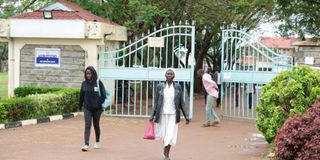Siaya fuel tanker disaster exposes inadequacies at referral hospitals

Members of the public are seen at entrance to Siaya County Referral Hospital on January 29, 2020. The facility does not have a specialised burn unit.
What you need to know:
- Siaya Referral is overstretched owing to the number of casualties who suffered serious burns in the tragedy.
The Malanga fuel tanker tragedy that has claimed 19 lives has exposed the inadequacy of some county referral hospitals to deal with fire disaster complications.
It has emerged that Siaya County Referral Hospital does not have a specialised burn unit, meaning it must transfer critically burnt patients to other facilities.
The tragedy has also put Siaya’s emergency response in the spotlight, with Governor Cornell Rasanga saying his government’s resources are overstretched and it needs support from well-wishers and donors.
“I am appealing for support from other stakeholders because we are overstretched. The county government is unable to sustain the treatment of the 20 because of the severity of the burns which need sophisticated specialised care,” he said.
Focus has now shifted to plans to transfer 20 patients at Siaya Referral who suffered severe burns to hospitals with specialised burn units for better care.
The decision was prompted by the deaths of six burn patients in the last four days.
Siaya Referral is overstretched owing to the number of casualties who suffered serious burns in the tragedy.
Transfers to KNH
Health executive Dismas Waklam said discussions were underway on the possibility of transferring serious burn cases to Kenyatta National Hospital (KNH) in Nairobi, the only public health facility with the unit.
KNH is among the few facilities that have established specialised burn units that can handle patients with any degree of burns.
Mr Wakla said Siaya Referral was in talks with KNH to move severe cases there. “We have been in discussions with KNH to have some patients transferred there since they have an established burn unit,” he said.
Other local leaders, including Dr George Jalang’o Midiwo, have urged the national government to help burn patients who cannot be treated in local hospitals.
“We have many people who have sustained 80 per cent burns yet the only facilities that can treat such are KNH and Moi Teaching and Referral Hospital. We call on the government to assist the victims,” he said.
The Malanga crash happened on Saturday night, killing 13 people. By Monday morning the deaths had risen to 15 after two more patients at Siaya Referral died. One patient tested positive for Covid-19 and was isolated.
On Tuesday, two more people - a 16-year-old boy with over 71 per cent burns and a pregnant woman who suffered 90 per cent burns – died, raising the number to 17.
On Wednesday, the deaths rose to 19 after two women aged 35 and 48 with at least 60 per cent burns died.
Siaya Referral cannot handle patients with severe burns.
Mr Rasanga said the five patients admitted to Yala Sub-County Hospital with at least 30 per cent burn injuries were all stable but still under medication. One patient at Inuka Hospital was in a similar condition.
When the Nation visited Yala Hospital on Wednesday, many of the survivors, including three boys, were seen sitting outside for fresh air, but were struggling to walk.
Cost factor
Governor Rasanga said that by Thursday, 20 people were still fighting for their lives at Siaya Referral.
He dismissed critics who have put the county government on the spot over the lack of a burn unit at the hospital, saying it is expensive to set it up.
“Setting up a burns unit is an expensive affair and that is why it is only KNH that has it. It has not been established in Siaya not because we do not have foresight but because resources we receive are not enough and are used for ailments that are much lighter,” he said.
He added that they receive inadequate funding from the national government.
The county boss pointed out that KNH can set up such facilities because it is a parastatal getting its funding directly from the national government and has a sense of autonomy in how it uses the funds.
Mr Rasanga said his government, the National Disaster Management Unit and the police are working to devise short-term and long-term strategies against future similar disasters.
Donations for families of the victims of the disaster, he said, will be channeled to a central kitty managed by the national disaster committee. He said he will personally give Sh500,000.
Mr Wakla, the county Health executive, told the Nation that they were in dire need of pharmaceuticals.
“In such emergencies where you have 19 deaths and are still nursing more than 26 other people, your facilities are bound to be overstretched,” he said.
“We are in need of drugs and other pharmaceuticals to help us handle the patients with burns.”
The situation was compounded by the fact that this is the first month of the new financial year and there is a lack of funds.
The KNH burn unit is located on the fourth floor of the hospital and is planning to build a Sh2.9 billion paediatric emergency and burns management centre with 82 beds, 14 ICU beds and six HDU beds.
It is expected to provide paediatric emergency services and improve preparedness and response to emergencies and disasters.





